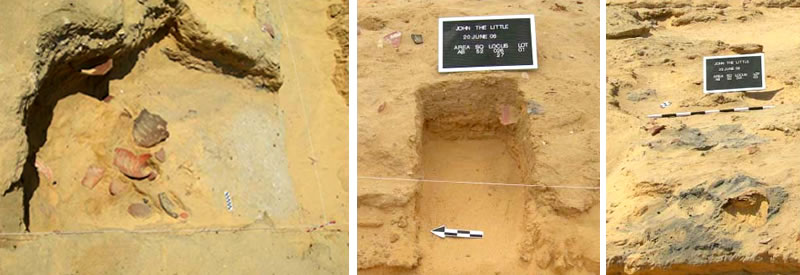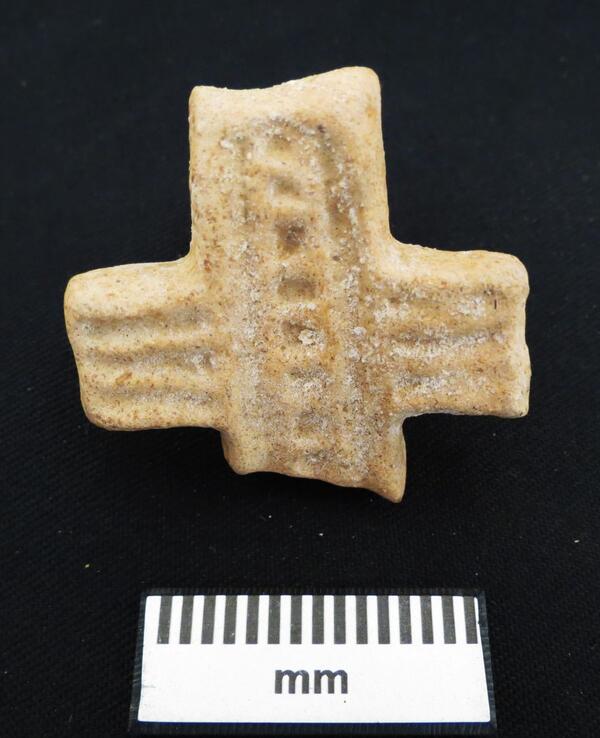Midden
A small archaeological mound some 300 m south of the church was selected for excavation on the basis of its significant surface sherd scatter and sub-surface features indicated by the geophysical survey.
A 20 x 10 m area was excavated in 2006 by Darlene Brooks Hedstrom, Chrysi Kotsifou, Paul Dilley, and Christine Luckritz Marquis (fig. 1). Mapping was completed by Dawn McCormack and field registration of excavated materials by Barbara Emmel. Mark Brooks Hedstrom managed the database and computer systems.
The frequent ash deposits, typically 1–1.5 cm deep, were consistent with episodic disposal of hearth or kitchen clearings. There were also discrete dumps of domestic waste, consisting of animal bones, plant materials, pottery, glass and a few objects.

Figure 1. Excavation of the midden, with deposits of pottery (left) and ash (right).
The animal bones were examined by Salima Ikram, who found that, as at the monasteries at Kūm al-Nānā and Bawīt in Middle Egypt, fish was the primary source of protein.[1] It is likely that most of these fish came from local sources within the immediate area of the monastery. The second most common animal was pig, followed by sheep/goat. Most of the pig bones were from parts of the animal that were often discarded. It is not known whether these were preferred or consumed out of necessity, or whether more pre-boned choice cuts were also consumed. Mennat-Allah El Dorry’s analysis of the plant remains showed that most were charred and very fragmentary. The material was rich in cereals, especially grains and pulses, but included very few wild species.
The pottery was found by Gillian Pyke to consist of types associated with domestic use, including vessels for food storage, preparation, cooking and dining. Transport vessels for moving and then storing food commodities were typically bag-shaped, thin-walled cooking vessels with cut-rims. Some of the polished dining vessels were produced in Aswan. The overall character of the assemblage was consistent with a ninth-century date. The ceramic vessels were complemented by drinking goblets, lamps, and small containers in glass, which were studied by Marie-Dominique Nenna. Most of these vessels were free blown, with few examples of mold-blown glass. Decoration was uncommon, but techniques of incision, applied threads, and pinching were used, the latter two common in the mid-eighth and ninth centuries. The small number of objects included a cross-shaped stamp with incised geometric decoration made from a clay type produced in the Aswan region (fig. 2).

Figure 2. Fired clay cross-shaped stamp.
Another significant component of the midden was architectural debris containing primarily wall and floor plaster but few mud bricks. These building materials were particularly concentrated in the south part of the midden and appeared to have been collected together for disposal. Much of this group was old plaster that had been removed and discarded, but some unused materials were also present, presumably leftovers from a renovation project. The window glass studied by Marie-Dominique Nenna probably also belonged to the architectural discards (fig. 3).

Figure 3. Glass from the midden.
There were various sizes of the characteristically circular panes of crown/bull’s-eye glass, which were in multiple colors, including blue-green (i.e. with no added color), violet, emerald, and deep blue. These window panes were similar to examples found at other monastic sites, such as Kellia, Esna, and Naqlun (Fayum).[2]
[1] For Kūm al-Nānā, see R. M. Luff, “Monastic Diet in Late Antique Egypt: Zooarchaeological Finds from Kom el-Nana and Tell el-Amarna, Middle Egypt, Environmental Archaeology 12.2 (2007), 161–174. For Bawīt, see S. Clackson, Something Fishy in CPR XX,” Archiv für Papyrusforschung und verwandte Gebiete 45 (1999), 94–95; S. Clackson, “Fish and Chits: The Synodontis Schall,” Zeitschrift für ägyptische Sprache und Altertumskunde 129.1 (2002), 6–11; W. Van Neer, W. Wouters, M.-H. Rutschowscaya, A. Delattre, D. Dixneuf, K. Desender, and J. Poblome, “Salted Fish Products from the Coptic Monastery at Bawīt, Egypt: Evidence from the Bones and Texts,” in The Role of Fish in Ancient Times, ed. H. H. Hüster Plogmann (Rahden 2007), 147–159.
[2] N. H. Henein and M. Wuttmann, Kellia 2. Volume 1: L’ermitage copte QR 195. Archéologie et architecture (Cairo 2000), 114–119, figs. 150–152; M. Mossakowska-Gaubert, “Verres de l’époque byzantine – début de l’époque arabe (Ve-VIIIe siècle): objets provenant des ermitages en Égypte,” in Annles du 18e congress de l’Association international pour l’histoire du verre, ed. D. Ignatiadou and A. Antonaras (Thessaloniki 2012), 357–366.
